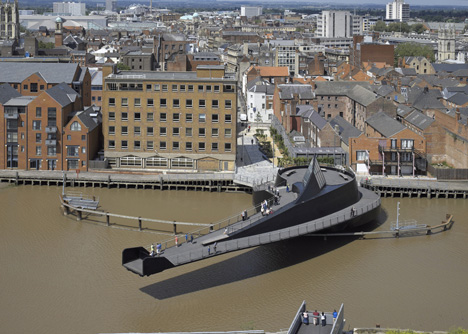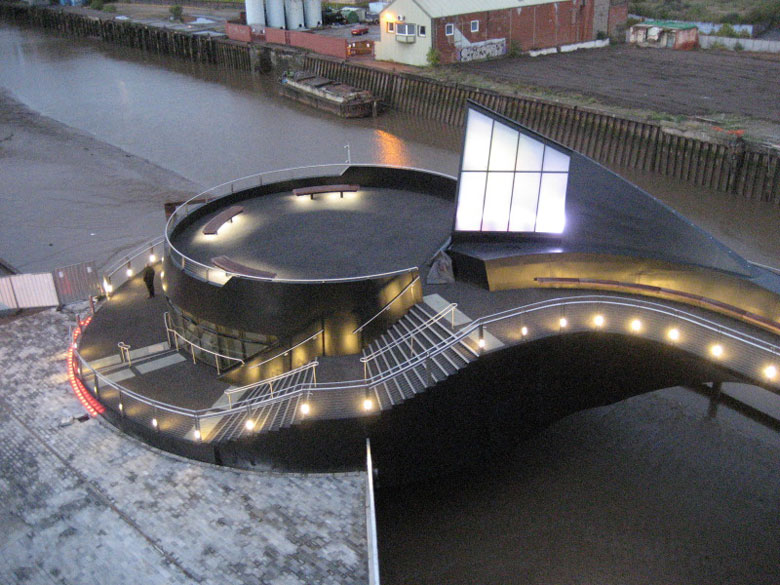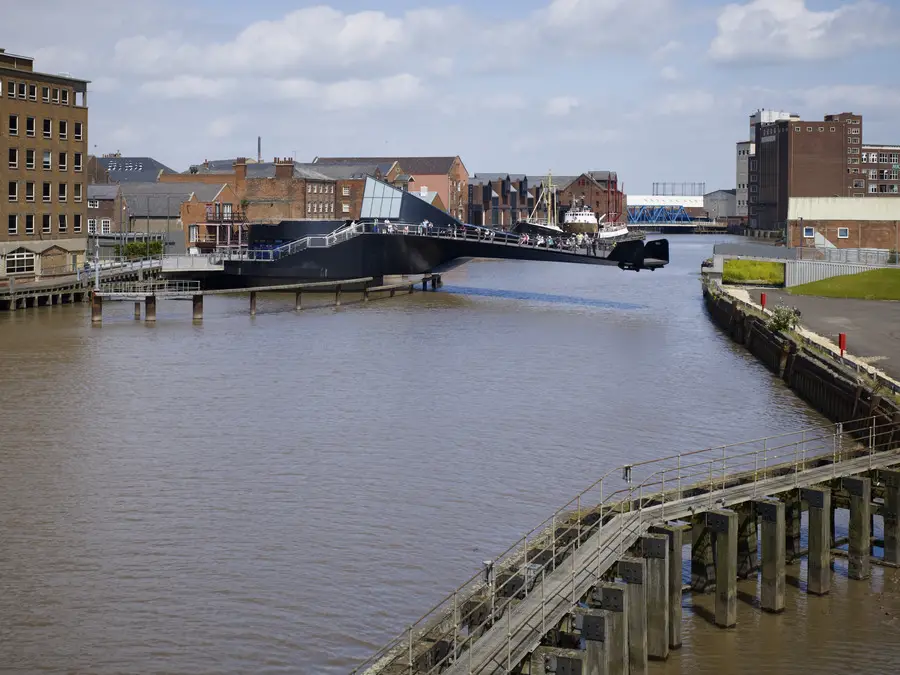Scale Lane Swing Bridge is a pedestrian and cycle bridge across the River Hull. This river was the reason for the development of the City of Hull, but has also been a distinct boundary between east and west that has intensified rivalries between the two Hull rugby league teams etc. There has never been a bridge in this area before as it was an early working area for shipping and has, until the 1970's, always been busy with barge and lighter traffic. Now the bridge links the Old Town historic and museum quarters, via Scale Lane, to the east bank and the Deep Aquarium. The east bank is the site of much future development that has been postponed by the crash of 2008, but now leads to the Deep Submarium. It was opened on Friday 28th June 2013 by the Lord Mayor of Hull.






www.dezeen.com/2013/08/05/scale-lane-bridge-by-mcdowellbenedetti/
Scale Lane Swing Bridge from the east bank.
The bridge has an overall span of 57 mt with 37 mt from the pivot and leaves a navigable channel of 30 mt. There are 350 tonnes of steel and 650 tonnes of concrete in its construction. When moving it can carry 1000 people and when closed 4000. The electric motors move the bridge smoothly and it can be fully open in 100 seconds.

http://www.jebiga.com/scale-lane-bridge-swinging-pedestrian-bridge/
West end of Scale Lane Bridge showing the seating area and retail unit.
The concept of a bridge in this area was conceived by Yorkshire Forward, a development organisation. The architects of the bridge were Jonathon McDowell and Renato Benedetti who had worked together since 1996. Their philosophy is to design a bridge as a destination, rather than just a means of crossing. The Scale Lane Bridge is probably the only moving bridge that allows passengers to remain on it whilst in operation. The bridge has to open to maintain the right of navigation up the River Hull. The 'roadway' has three levels, one that has no steps, one with steps down and up to a third seating level at the top. There are also seats between the two levels. The shape is like an apostrophe or a like a pinball 'flipper' arm.

http://www.waagner-biro.com/en/company/news-press/news/scale-lane-footbridge-hull
The full span across the River Hull.
The concept was engineer designed by Alan Baxter Associates and they have incorporated a smooth and graceful mechanism that allows pedestrians to remain on the bridge when in operation. Alan Baxter Associates have been in business since 1974 and have been involved with designing railway stations, and projects at Hampton Court, Salisbury Cathedral and the Palace of Westminster. Alan Baxter Associates and McDowell, Benedetti collaborated building the bridge over the River Aire weir at Castleford.

photos © Timothy Soar http://www.e-architect.co.uk/england/scale-lane-bridge
The approach to Scale Lane Bridge from the south passing under the Tidal Barrier and the Myton Road Bridge.
The construction was carried out by Qualter Hall, company founded in Lancashire in 1860, when George Bower designed and patented a new piston and ring. To build it he joined with blacksmith John Qualter and engine fitter Edward Hall. Unfortunately the American Civil War then caused severe hardship in Lancashire as the cotton mills closed through lack of cotton. Qualter and Hall 'emigrated' over the boarder to Yorkshire, and set up in Barnsley. Here they got involved with railways. After the Civil War the three then made the new type of piston that proved its worth. They then became involved in building winding and haulage engines for the mining industry, and also built a stand for Barnsley Football Club. After the coal mining industry fell away they became involved in bespoke project engineering for mines, power generation, water, transport, rail and port projects as well as nuclear, in the UK and worldwide.

http://www.qualterhall.co.uk/projects.php?num=1
Scale Lane Swing Bridge by night.
On the west bank approach the bridge is complimented by a public artwork by Nayan Kulkarni. The area is measured out with bronze strips that have back lit names of historic parts of ships set in to them. The area is planted up with separate seating areas and the whole area is bathed in birdsong from concealed speakers to create a calming and rural soundscape. When the bridge is due to open a rhythmic bell and light operate from the bridge as a gentle warning to pedestrians. On the east side a gate is closed to prevent access, but on the west people can step on and off the bridge whilst the bridge is in motion. Over the pivot area is a retail unit that is still to be let. The design and build has won many awards, including the Civic Trust and RIBA Yorkshire.
To ride on the bridge it is opened most weekends, regardless of river traffic usage. The times will alter with the tides but on Saturday they are usually 1100 or 1500, and on Sunday 1030 or 1100. To check the times please see; http://www.hullcc.gov.uk/portal/page?_pageid=221,851675&_dad=portal&_schema=PORTAL
No comments:
Post a Comment